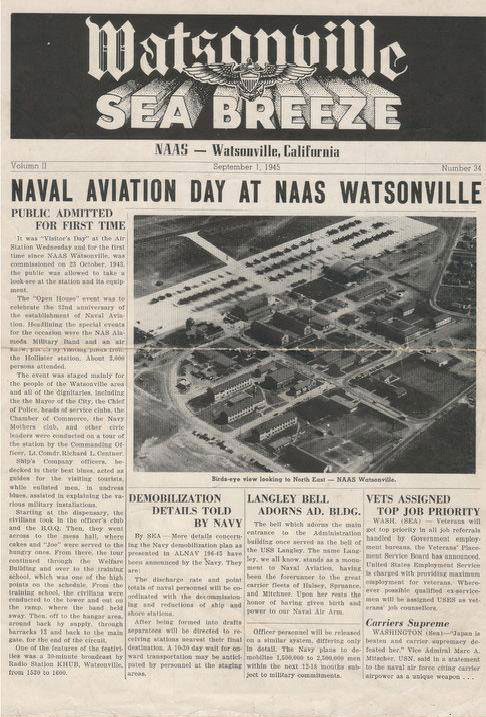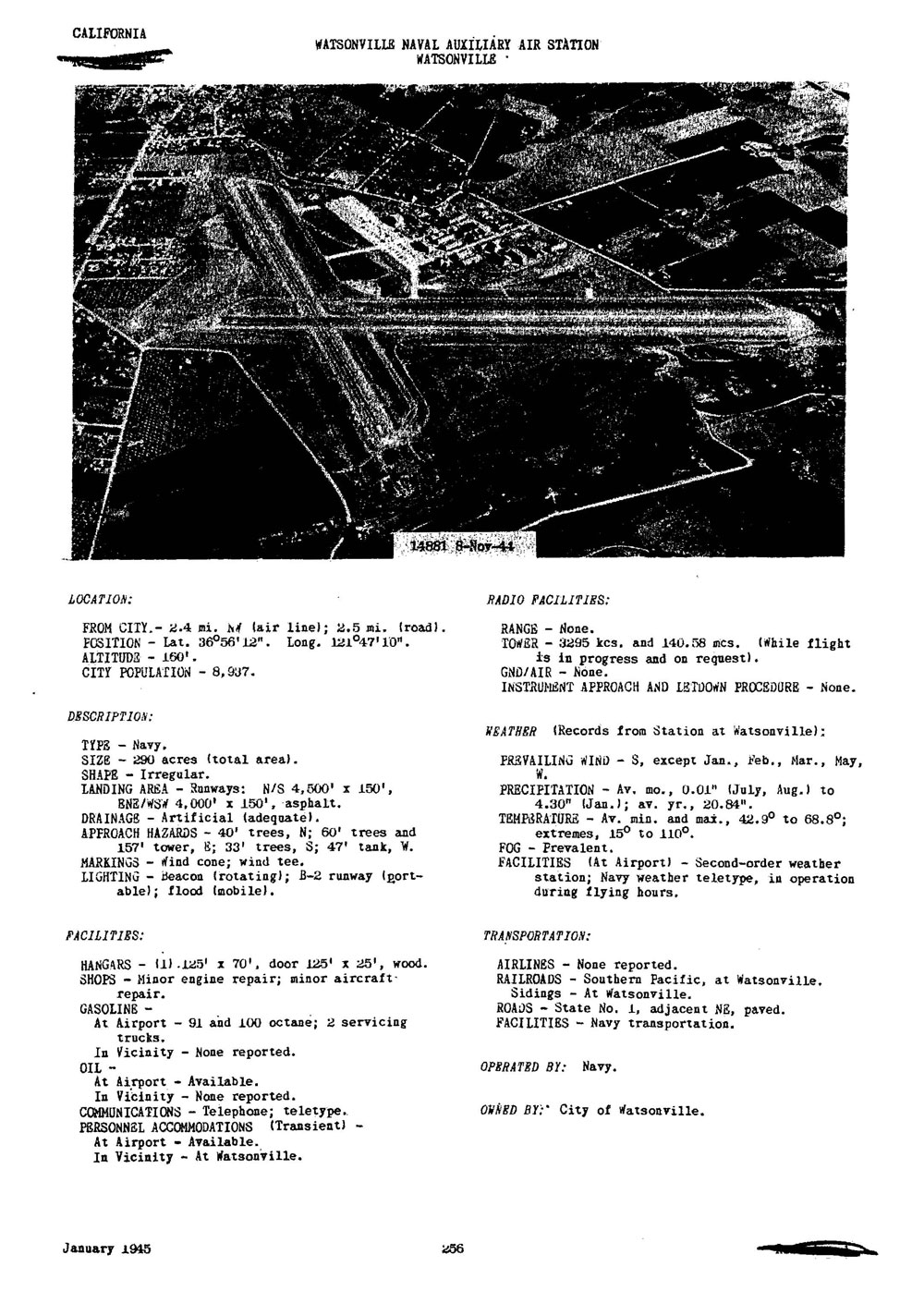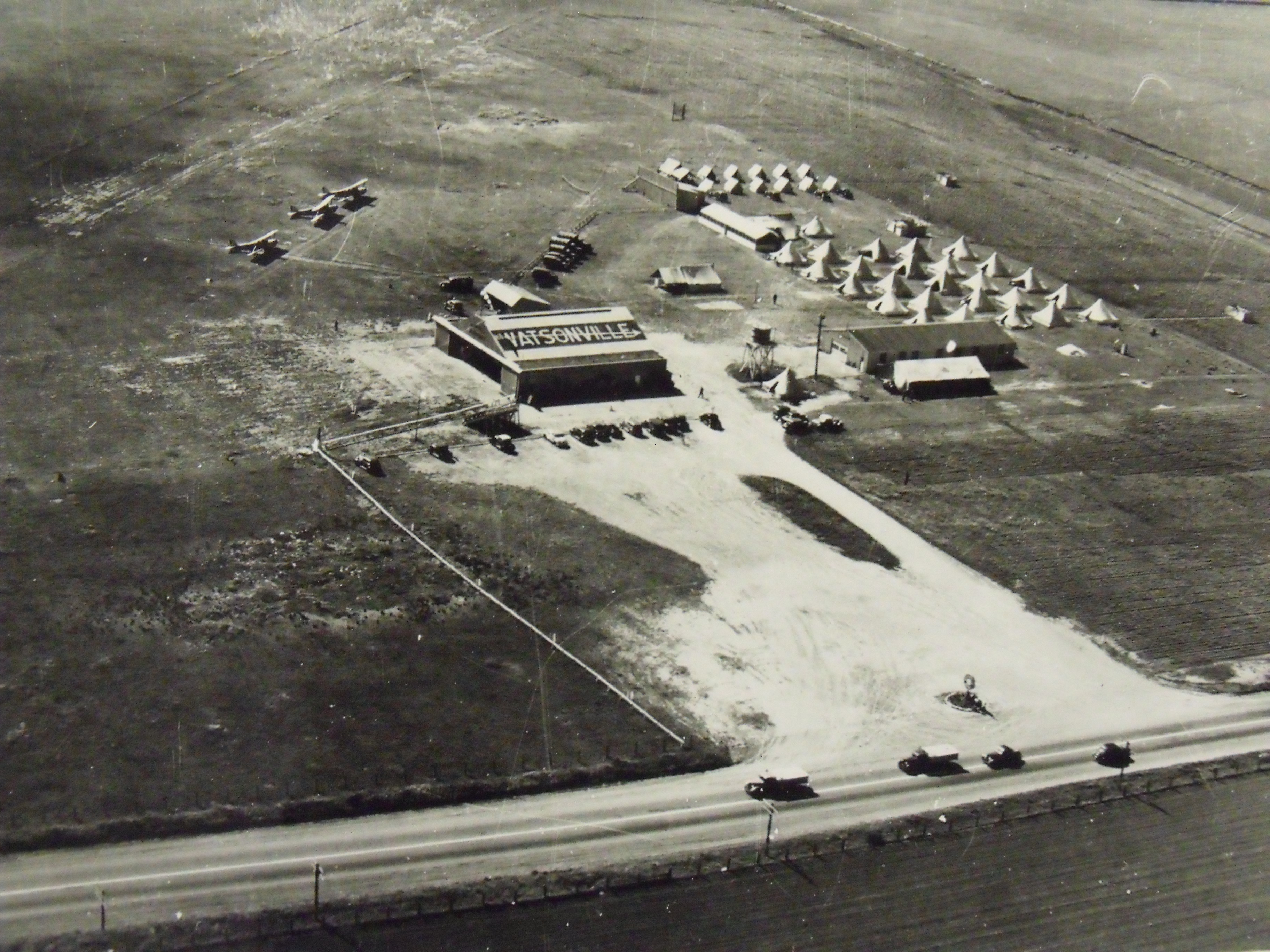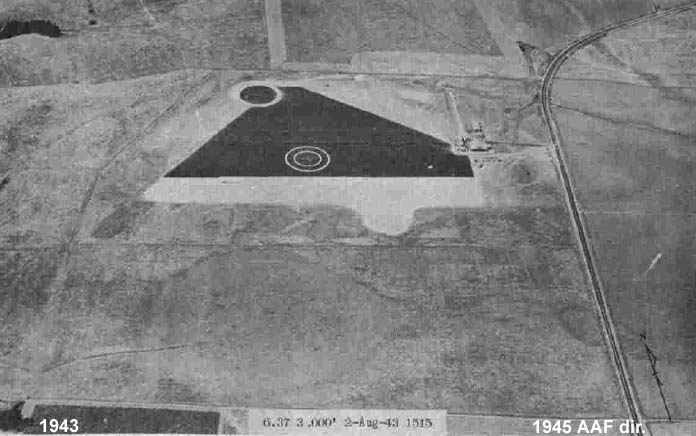
Naval Aviation at Watsonville during World War II consisted of two facilities. The new CAA built airport became a carrier aircraft station as an auxiliary of Alameda. The Navy never liked mixing heavier than-air operations with blimp operations if avoidable. Therefore, the local airport was taken over and an NAAF for blimp use established -- this facility was an auxiliary of Moffett.

History by Justin Ruhge
The Watsonville Naval Auxiliary Air Station was an auxiliary field to Naval Air Center Alameda. It was the final link in the chain of auxiliary air stations grouped around Alameda. The Station was commissioned on October 23, 1943. The Station filled the need for additional training facilities and services for support, operation, maintenance, and training of fleet Units and personnel. In the echelon of command, the Station was responsible to Commander, Naval Air Bases, 12th Naval District, Alameda, California. The Station was built especially for the Navy under the direction and supervision of the Bureau of Yards and Docks, 12th Naval District. The Combat Aircrew Refresher Training Unit was established with the first Officer-in-Charge Lieutenant John C. Chapman on August 29, 1943.
The site of the Station at Watsonville was taken over by the Navy on July 1, 1943. Two hundred eight-seven acres of land owned in fee simple by the City of Watsonville were leased to the Navy on June 1, 1943. The Navy purchased tracts adjacent to this parcel totaling 35 acres. The Station buildings were located on this tract.
Prior to this action by the Navy the City of Watsonville had entered an agreement with the Civil Aeronautics Authority in 1942 for the development of the Watsonville Airport on the 287 acres. Work on the airfield had been underway for some time under the direction of the Army Corps of Engineers. Approximately $740,000 had been spent on the site before the Navy acquired it. The City had spent $280,000 to acquire the land.
Construction by the Navy began in July 1943 on Bachelor Officers' Quarters, an administration building, a fire station, a supply building, two barracks, a mess hall, a hangar and a control tower. When the first Naval personnel reported aboard on August 29, 1943 none of the buildings had been completed. Food was acquired from Fort Ord and cooked on an Army field range and served in the carpenter's shop near the firehouse. The initial construction was completed by October 1943. During 1944 many buildings continued to be added to accommodate the growing number of personnel and services needed for them. In December 1944 the expansion of the airfield to accommodate 90 aircraft instead of 45 was completed as well as a Kodiak hangar. F6F Hellcats were flown out of Watsonville as well as TBFs and FM2s
A building for Free Gunnery Training was completed and put into use about October 1944. This structure provided space for a fifty-man ground school. Simulators were used to train gunners in their art.
Some of the blimps from the Moffett Air Station were stationed at the Watsonville Naval Auxiliary Air Facility (See below).
The Field newspaper was called the Watsonville Sea Breeze and first published on September 22, 1944.
On August 14, 1945 it was announced that Japan had surrendered. On September 6, 1945, the Chief of Naval Operations advised that effective October 15, 1945 the Station was to be placed on caretaker status. The Station was returned to the City of Watsonville in 1947.
References:
US Army Corps of Engineers Sacramento District History (2007)
In 1939, the Civil Aviation Adminitration (CAA) offered to build an airport at Santa Cruz, the largest city in Santa Cruz County and the county seat, if the necessary land was provided. After Santa Cruz turned down the proposal, the CAA then approached the City of Watsonville -- the second largest city in the county. A small airport existed four miles southsouthwest of town, but it was inadequate for the modern facility planned by the CAA. Watsonville floated a bond issue for $125,000 to purchase 330 acres, 2.5 miles northwest of town. The CAA completed its initial work by the end of 1941. During 1942, the CAA made additional improvements spending a total of $740,000 on the project that resulted in a 4,500 and a 4,000-ft. macadam runway. In mid-1943, the Navy leased the airport's 288 acres from Watsonville and purchased 35 additional acres to build administration and barracks buildings. Navy construction began in July 1943, and the station commissioned on October 1.
In October, VB-18 with 36 SBDs arrived along with a detachment of CASU 19 in support. On November 14, VF-28 and 24 F6Fs flew into Watsonville for a two week stay. On December 9, VB-18 departed for Crows Landing, replaced by VF-26's and VF-27's 48 F6Fs. In December, the station suffered its first fatality in the crash of a VF-27 F6F. That month, CASU 35 relieved CASU 19.
In February 1944, VF-26 and VF-27 moved to other stations as VT-28 and VF-28 arrived. The CASU merry-go-around continued as CASU 37 relieved CASU 35. From March to July 1944, CAG 22's VF-22 and VT-22 trained aboard. CAG 23's fighter and torpedo squadrons were present from July to October. On July 16, an F6F of VF-23 hit the tower of the local radio station. The pilot later died of injuries. During the year, the Navy spent $1.2 million enlarging the station to accommodate 90 aircraft. Improvements included a new administration building, four barracks and a BOQ, and a Gunnery Training building. In November, the CASU situation stabilized with the forming of CASU 64 that absorbed the personnel of CASU 37. The end of the year found VC-33 and VOC-2 at the station. VOC 2, an observation composite squadron, had a complement of 23 FM-2s and six TBM Avengers.
On January 15, 1945, CAG 8, the first large air group arrived after reforming at Alameda. CAG 8's 96 aircraft consisted of VF-8 with F6Fs, VBF-8 also with F6Fs, VB-8 with SB2Cs, and VT-8 with Avengers. On May 17, CAG 8 departed for Alameda prior to embarking for Hawaii. Shortly thereafter, CAG 4 came aboard with a similar make up excepting that its VBF squadron was equipped with Corsairs. The diverse Corsair squadron consisted of F3As, FGs, and F4Us. CAG 4 departed for Groton, Connecticut after VJ-Day. On October 15, 1945, the station went on caretaker status.
The airport was opened for civilian use and the Navy finally turned over all facilities to the City in March 1947. Until 1963, some of the former Navy buildings were used as a school. Today, the airport is used by general aviation.
Extract , US Army Air Forces Directory of Airfields (January 1945)


History by M.L. Shettle

The first airport was established in Watsonville in 1930. A group of investors and aviation enthusiasts formed a corporation known as the "Watsonville Airport, Inc." The corporation issued 5,000 shares of stock, mostly purchased by local citizens. With the funds raised, 85 acres were bought four miles southsouthwest of Watsonville. Although Watsonville is located in Santa Cruz County, the property purchased was across the county line in Monterey County -- the most reasonably priced land available at the time. An aircraft carrying California Governor James Rolph made a low pass cutting a ribbon, officially pening the airport on May 9, 1931.
In 1942, the Navy leased the airport and established an auxiliary blimp base of Moffett. The station opened August .6, 1943. Moffett's ZP-32 usually maintained a detachment of one to two K-ships at the base that conducted patrols of the Monterey area. The facility had three asphalt runways -- the longest 2,300 ft. and three blimp mooring circles. Apparently the entire airfield was paved or oiled. Peak complement consisted of nine officers and 96 enlisted men with barracks for 15 officers and 101 men. The Navy utilized the existing 60 x 60-ft. hangar on the airport. Although the NAAF was officially a separate command, facilities were minimal at best and NAAS Watsonville was undoubtedly relied upon for much of its administrative support as well as supply of the 1,001 items needed to operate an airbase. As far as is known, nothing unusual or of note occurred at the facility during the war.
Following the war, the Navy returned the 87 acres to the corporation. When the heavier-than-air station northwest of town was deeded to the City, the former blimp facility was abandoned. In May 1947, the corporation sold the property to an individual who used it for a cattle feed lot.
.jpg)
Copied with the permission of the author from United States Naval Air Stations of World War II.
Extract , US Army Air Forces Directory of Airfields (January 1945)
%20Watsonville.jpg)

Additional History
Abandoned and Little Known Airfields